
In ancient Greek mythology and religion, Leto is a goddess and the mother of Apollo, the god of music, and Artemis, the goddess of the hunt. She is the daughter of the Titans Coeus and Phoebe, and the sister of Asteria.
Laima is a Baltic goddess of fate. She was associated with childbirth, marriage, and death; she was also the patron of pregnant women. Laima and her functions are similar to the Hindu goddess Lakshmi.
In Latvian mythology, the term ' stands for "mother", sometimes written in English as Mhte'. It was an epithet applied to some sixty-seventy goddesses. were clearly distinct goddesses in most or all cases, so the term definitely referred to the mother-goddess of specific phenomena. According to professor Lotte Motz, scholar Haralds Biezais mentioned there were at least 70 characters in Baltic religion identified with the title of Mate.

Nut, also known by various other transcriptions, is the goddess of the sky, stars, cosmos, mothers, astronomy, and the universe in the ancient Egyptian religion. She was seen as a star-covered nude woman arching over the Earth, or as a cow. She was depicted wearing the water-pot sign (nw) that identifies her. Nut is comparable to the Mesopotamian goddess Ninhursag also sharing her role as mother of the gods.

Amunet or Imnt ; also spelled Amonet or Amaunet; Koinē Greek: Αμαυνι) is a primordial goddess in ancient Egyptian religion. Thebes was the center of her worship through the last dynasty, the Ptolemaic Kingdom, in 30 BC. She is attested in the earliest known of Egyptian religious texts and, as was the custom, was paired with a counterpart who is entitled with the same name, but in the masculine, Amun. They were thought to have existed prior to the beginning of creation along with three other couples representing primeval concepts.
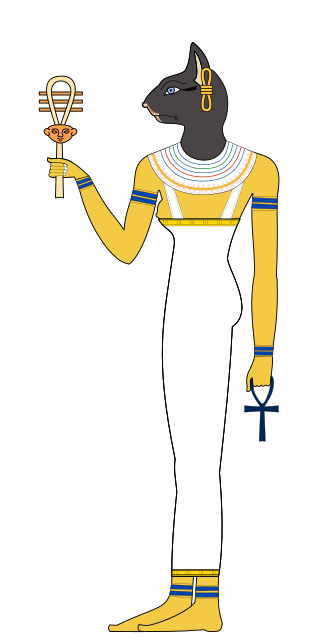
Bastet or Bast was a goddess of ancient Egyptian religion, worshipped as early as the Second Dynasty. Her name also is rendered as B'sst, Baast, Ubaste, and Baset. In ancient Greek religion, she was known as Ailuros.
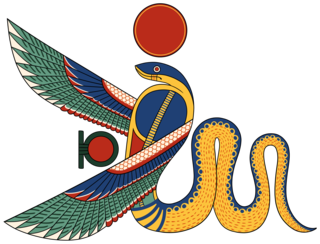
Wadjet, known to the Greek world as Uto or Buto among other renderings including Wedjat, Uadjet, and Udjo, was originally the ancient Egyptian local goddess of the city of Dep. It became part of the city that the Egyptians named Per-Wadjet and the Greeks called Buto, which was an important site in prehistoric Egypt and the cultural developments of the Paleolithic. There was also a Per-Wadjet in Upper Egypt.

Heka was the deification of magic and medicine in ancient Egypt. The name is the Egyptian word for "magic". According to Egyptian literature, Heka existed "before duality had yet come into being." The term ḥk3 was also used to refer to the practice of magical rituals.

Anuket was the ancient Egyptian goddess of the cataracts of the Nile and Lower Nubia in general, worshipped especially at Elephantine near the First Cataract.

Meretseger was a Theban cobra-goddess in ancient Egyptian religion, in charge with guarding and protecting the vast Theban Necropolis — on the west bank of the Nile, in front of Thebes — and especially the heavily guarded Valley of the Kings. Her cult was typical of the New Kingdom of Egypt.
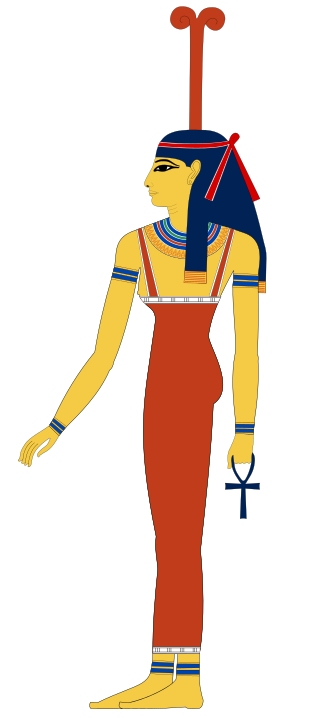
In ancient Egyptian mythology, Meskhenet, was the goddess of childbirth, and the creator of each child's Ka, a part of their soul, which she breathed into them at the moment of birth. She was worshipped from the earliest of times by Egyptians.
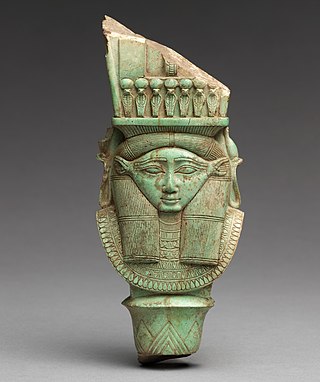
Bat is a cow goddess in Egyptian mythology who was depicted as a human face with cow ears and horns or as a woman. Evidence of the worship of Bat exists from the earliest records of the religious practices in ancient Egypt. By the time of the Middle Kingdom, after the unification of Lower Egypt and Upper Egypt, her identity and attributes were subsumed within that of the goddess Hathor, a similar goddess worshiped in another nome. The imagery of Bat persisted throughout the history of ancient Egypt on the sistrum, a sacred instrument that remained associated with religious practices.

Werethekau was an ancient Egyptian deity. She served as the personification of supernatural powers.
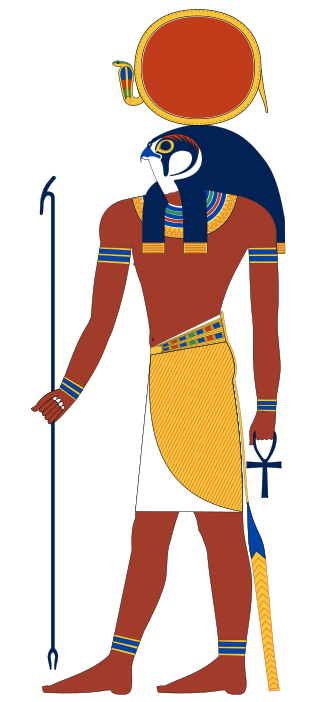
Ra or Re was the ancient Egyptian deity of the sun. By the Fifth Dynasty, in the 25th and 24th centuries BC, he had become one of the most important gods in ancient Egyptian religion, identified primarily with the noon-day sun. Ra ruled in all parts of the created world: the sky, the earth, and the underworld. He was the god of the sun, order, kings and the sky.
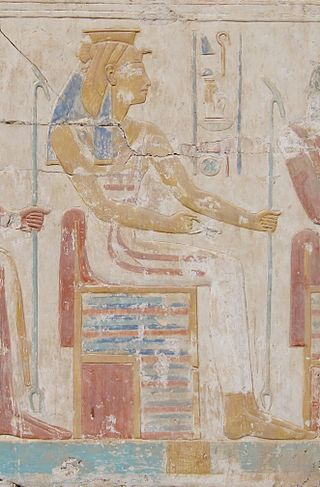
Heqet, sometimes spelled Heket, is an Egyptian goddess of fertility, identified with Hathor, represented in the form of a frog. To the Egyptians, the frog was an ancient symbol of fertility, related to the annual flooding of the Nile. Heqet was originally the female counterpart of Khnum, or the wife of Khnum by whom she became the mother of Her-ur. It has been proposed that her name is the origin of the name of Hecate, the Greek goddess of witchcraft.
Iat is an ancient Egyptian minor goddess of milk and, by association, of nurturing and childbirth.
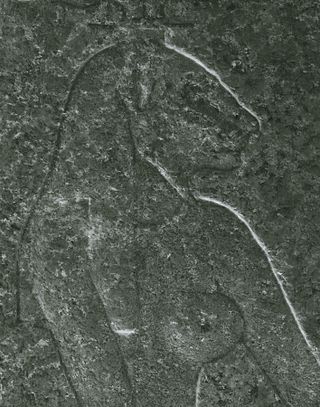
Mehit or Mehyt was an ancient Egyptian goddess. In the Early Dynastic period she was depicted as a reclining lioness with three bent poles projecting from her back. In that era she appears in numerous early dynastic sealings and ivory artifacts, usually together with a representation of an Upper Egyptian shrine. Her main places of worship were Hierakonpolis and Thinis.

A deity or god is a supernatural being who is considered divine or sacred. The Oxford Dictionary of English defines deity as a god or goddess, or anything revered as divine. C. Scott Littleton defines a deity as "a being with powers greater than those of ordinary humans, but who interacts with humans, positively or negatively, in ways that carry humans to new levels of consciousness, beyond the grounded preoccupations of ordinary life".
Ipy is an ancient Egyptian goddess of fertility. She is also known as Opet. At Karnak she is called Ipet, and in the Demotic Magical Papyrus, she is called Apet, the mother of fire.















